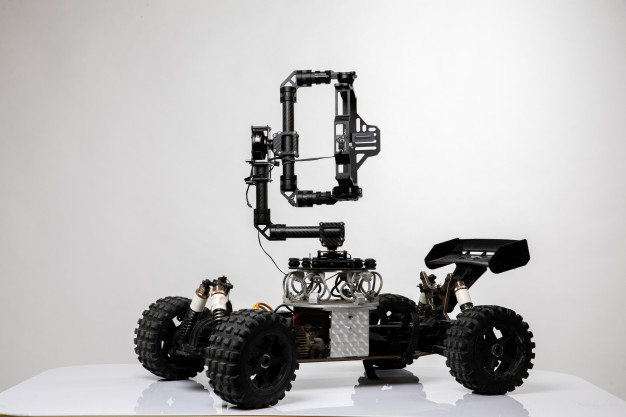Unit 7 Materials

Robots operate in the physical world. Various engineering materials are used in robots to provide shape, strength and durability. Metals, plastics, and composites tend to dominate the structural elements, but other materials are occasionally used.
Source: Adapted from the article “Structural Materials for Robots” (Nelson 2020).
7.1 Reading: Robot Materials
Here are some of the materials to keep in mind when designing and building robots.
Steel is one of the materials used most often by robot builders. This sturdy metal is a smart choice if you’re building a robot that needs to stand up to harsh conditions. It’s possible to harden the steel to between 100,000 and 300,000 pound-force per square inch (psi) in many cases.
Demand is growing for commercial robots with flexible exteriors, such as human-like “skin.” Moreover, it’s advantageous for cobots that work alongside humans to have soft surfaces. Rubber and soft plastics can meet that goal.
Although aluminum has a higher price point than steel, it’s easier to shape and is lighter. Aluminum is also a good material if you’re worried about a robot’s exterior becoming rusty over time because aluminum does not rust. However, because it can corrode in some wet environments, you might consider treating the surface to give it more protection against possible corrosion.
Kevlar is a synthetic fiber frequently used for bulletproof vests. Some of its characteristics make it worth evaluating for robot exteriors, too. You could use it as a covering on robots that require safeguarding from extreme temperatures. Many heat-resistant gloves feature Kevlar because the material does not melt or drip when exposed to hot environments.
Investors and developers have become increasingly aware of the need for eco-conscious and sustainable robotics development. Recycled materials and biodegradable plastics would go a long way to helping them achieve that goal.
This is just an introductory list to some of the most commonly used materials for robot exteriors. Of course, the material a robot uses will depend primarily on its purpose. For instance, materials used in robot-assisted surgery must be able to withstand rigorous sterilization techniques. In this case, a polymer like acrylonitrile butadiene styrene (ABS) would fare far better than a material that can’t stand up to medical requirements and regulations.
Some soft robotics materials can even “feel” pain and heal themselves.
Source: Adapted from the article “5 materials to evaluate for designing, building robust robots” (robotplatform.com 2021a).
- What are the materials mentioned in the text?
Show/Hide solution
steel, rubber, aluminum, kavlar, recycled materials, biodegradable plastics, polymer- Why are recycled materials and biodegradable plastics used in robots?
Show/Hide solution
the need for eco-conscious and sustainable robotics development- What is the field of robotics using materials that can “feel” pain and heal themselves?
Show/Hide solution
soft robotics7.2 Writing: Properties of Materials
Steel is the most common and least expensive metal, and also one of the strongest. Unhardened mild steel yields at 30,000-50,00 psi. For structural purposes, it can be hardened easily to 100,000 psi, and for tooling, can be strengthened to nearly 300,000 psi. It has a density of approximately 8 times the density of water (7.9 gm/cc), and a melting point around 1400 degrees C (pure iron 1530 C), which looks white hot.
7.3 Speaking: What is This Robot Made of?

7.4 Listening: Self-healing Robot
Any small rips or punctures could render these devices unusable.
To combat this, researchers have built soft robots with a material that, with a little heat, can reassemble itself after some types of damage.
The robots get this
They are made entirely of a synthetic material called an elastomer, short for “elastic
When heated, the molecular bonds that keep the elastomer together loosen, and begin to reform back to their original cube-like
A little over an hour after being damaged, the material was almost completely healed, and 24 hours after cooling, the only evidence was a small scar. In testing, this material was adapted to a robotic hand, a gripping claw, and an artificial muscle. Each one represents a standard use for a soft robot, and each one was successfully able to heal when heated.
The robots could withstand cuts and stabs, and achieved nearly-full
Even after two healing
The researchers say that these
Show/Hide solution
Soft robots; healing; polymer; shape; performance; cycles; self-healing7.5 My Glossary
Translate these terms into your language.